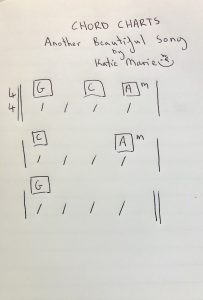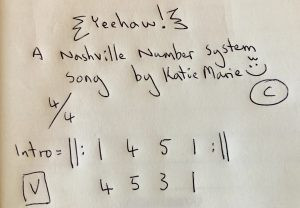Being prepared with accurate chord charts is essential for a smooth and productive recording session. Whether you’re a songwriter hiring session musicians or a guitarist heading into the studio, clear and easy-to-read charts ensure everyone is on the same page, musically speaking. Over years of diverse recording experiences, I’ve seen everything from meticulously detailed scores to just rough MP3s. The sessions that run most efficiently are always those where musicians are provided with quality charts right from the start. Good charts minimize time wasted on editing misunderstandings or creating charts on the fly during valuable studio time, letting everyone focus on what matters most: making great music.
Getting Started: Understanding Song Structure
Before diving into different types of charts, it’s crucial to establish a clear song structure. This acts as a roadmap for all musicians involved, outlining the song’s progression. To keep charts concise and easy to follow, standard abbreviations are widely used:
- V: Verse
- CH or C: Chorus
- B or BD: Bridge
- Inst: Instrumental
For musicians familiar with UK terminology, the Bridge is often referred to as a “Middle 8,” abbreviated as “M8” in charts. While some might differentiate between a Bridge and a Middle 8 technically, in practical session scenarios, especially with UK musicians, “Middle 8” usually indicates the bridge section.
Exploring Different Types of Guitar Chord Charts
Once the song structure is clear, you can choose the chart type that best suits your needs and the complexity of the music, especially when focusing on guitar chords. While these examples are applicable to various melodic instruments, they are particularly relevant for guitarists and can be adapted for drums and percussion as needed.
1. Lyrics with Guitar Chords
 Lyrics with chords
Lyrics with chords
Alt text: Example of lyrics with guitar chords chart, showing song verses with chord names written above the lyrical phrases.
This is often the preferred chart type, especially for guitarists learning basic chords and for sessions where simplicity is key. Lyrics with chords are incredibly straightforward to follow. Chord names are written directly above the lyrics where the chord changes occur. This method’s simplicity makes it excellent for quickly grasping the basic harmonic structure of a song, particularly for guitarists who are more comfortable with lyrics than traditional music notation.
However, this type of chart has limitations. It doesn’t precisely indicate the rhythmic placement of chords within a measure, which can be important for more intricate musical parts. Despite this, lyrics with chords are a fantastic starting point, especially if you’re new to music theory or need to create a quick and easy chart for basic guitar chord progressions.
2. Standard Guitar Chord Charts
 Chord Charts
Chord Charts
Alt text: Example of a standard guitar chord chart in 4/4 time signature, showing chord names and rhythm markings indicating beat duration for each chord within the bar.
Standard chord charts provide more rhythmic information than lyrics-with-chords charts. They are particularly useful for guitarists who need a clearer picture of the rhythmic feel of a song. Typically, these charts display chord names arranged in bars, reflecting the song’s time signature.
In the example above, the song is in 4/4 time, meaning each bar contains four beats. Beneath the chord names, you’ll see rhythm markings – in this case, lines – indicating the duration of each chord. In the first bar, “G” has two lines, “C” has one, and “Am” has one, signifying their relative durations within the 4-beat bar. This visual representation of rhythm is invaluable for guitarists to understand the timing and feel of chord changes.
Another common way to represent rhythm is by implicitly assigning the first chord in a bar to the first beat and then indicating subsequent beats for following chords. For instance, in the example provided, both the “G” and “C” chords are shown with implied two-beat durations. This method keeps the chart clean while conveying essential rhythmic information for guitarists.
3. Nashville Number System for Chord Charts
 Nashville Number System
Nashville Number System
Alt text: Example of a Nashville Number System chart, showing numbers representing chords within a key, facilitating key changes without rewriting the entire chart.
The Nashville Number System offers a streamlined approach to charting, especially beneficial in songwriting and arranging stages where key changes might be frequent. While it’s a more abstract system initially, it’s powerful for experienced musicians and can be adapted for guitar chord charts.
How it functions: Instead of chord letters (like G, C, D), numbers represent chords within a key. In a major key: 1=Major, 2=Minor, 3=Minor, 4=Major, 5=Major, 6=Minor, 7=Diminished. A similar system exists for minor keys.
For a song in C major (C, D, E, F, G, A, B), the numbers correspond to chords built on these scale degrees. For example, a two-bar verse progression in C major might be written numerically as:
[ 1 1 4 5 ] [ 1 1 2 2 ]
This translates to chords: C C F G and C C Dm Dm. The beauty of this system is key transposition. If you decide to shift the key to G major, the number chart remains the same:
[ 1 1 4 5 ] [ 1 1 2 2 ]
Now, applying the G major scale (G, A, B, C, D, E, F#), the same number progression becomes: G G C D and G G Am Am. This key-agnostic approach is incredibly efficient for collaborative songwriting and studio flexibility.
The Nashville system also uses symbols for rhythmic nuances, like a diamond for sustained chords or a “^” for staccato. While these exist, traditional rhythm notation can also be integrated for clarity, especially in guitar chord charts. Exploring resources dedicated to the Nashville Number System can further expand your understanding and application.
4. Full Music Score
For ultimate detail, a full music score notates every aspect of a song, including melody, rhythm, harmony, and instrumentation. This is the most comprehensive charting method. While incredibly thorough, it’s worth noting that outside of classically trained musicians, many contemporary players, including guitarists in popular music genres, may not be fluent in reading full scores.
However, professional studio musicians are often comfortable with music notation, and a full score is undeniably the most precise way to communicate every musical detail. If absolute precision is paramount and you are working with musicians who can read scores, this is the definitive method.
Final Thoughts on Chord Charts
Creating effective chord charts, especially for guitar, is a vital skill for songwriters and musicians. Whether you opt for the simplicity of lyrics with chords, the rhythmic clarity of standard chord charts, or explore the flexibility of the Nashville Number System, the goal is clear communication in the studio.
Do you have a preferred method for charting guitar chords or songs in general? Are there any apps or tools you find particularly helpful for creating charts? Your experiences and recommendations are welcome in the comments below. Thank you for reading!
